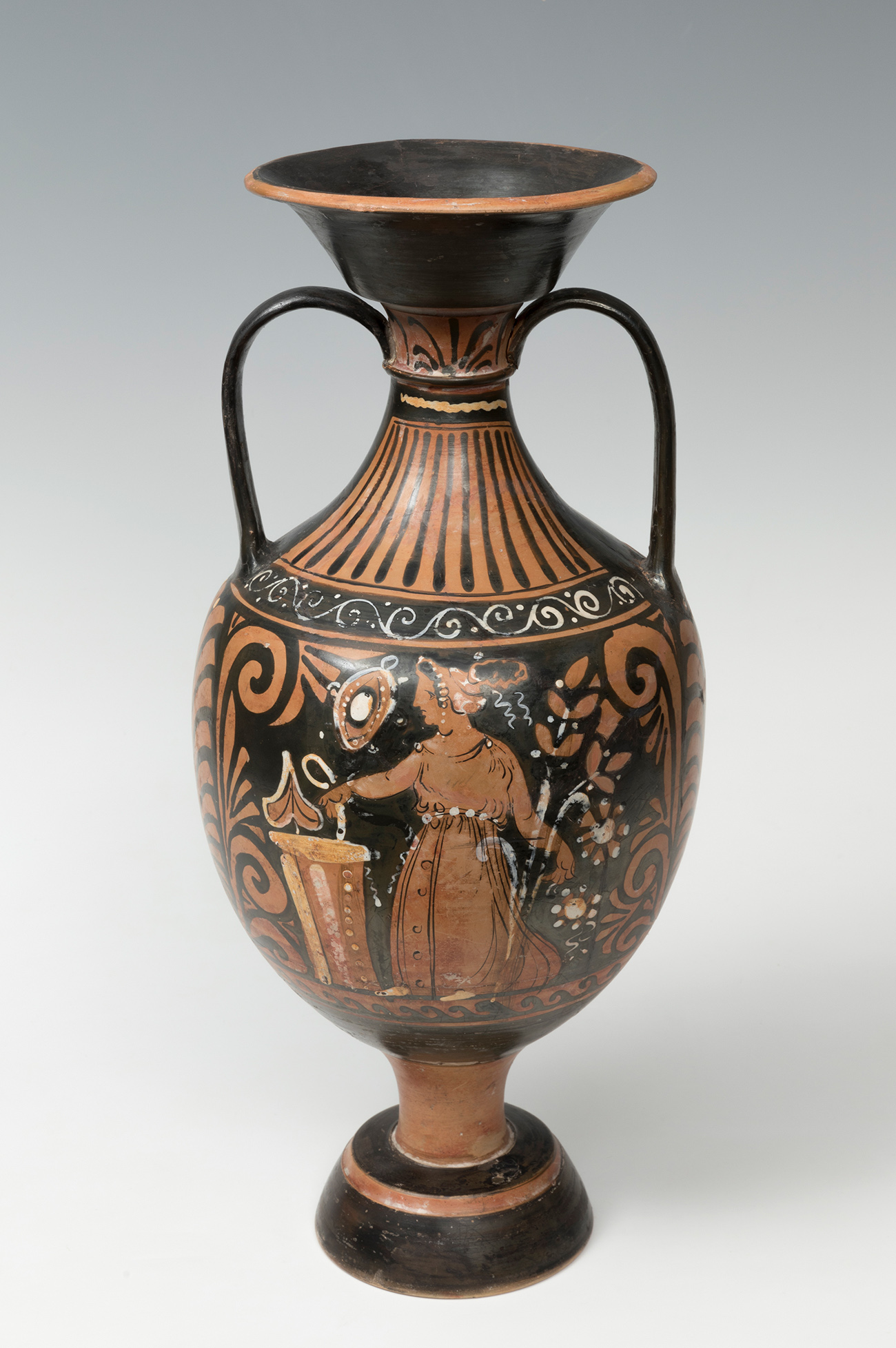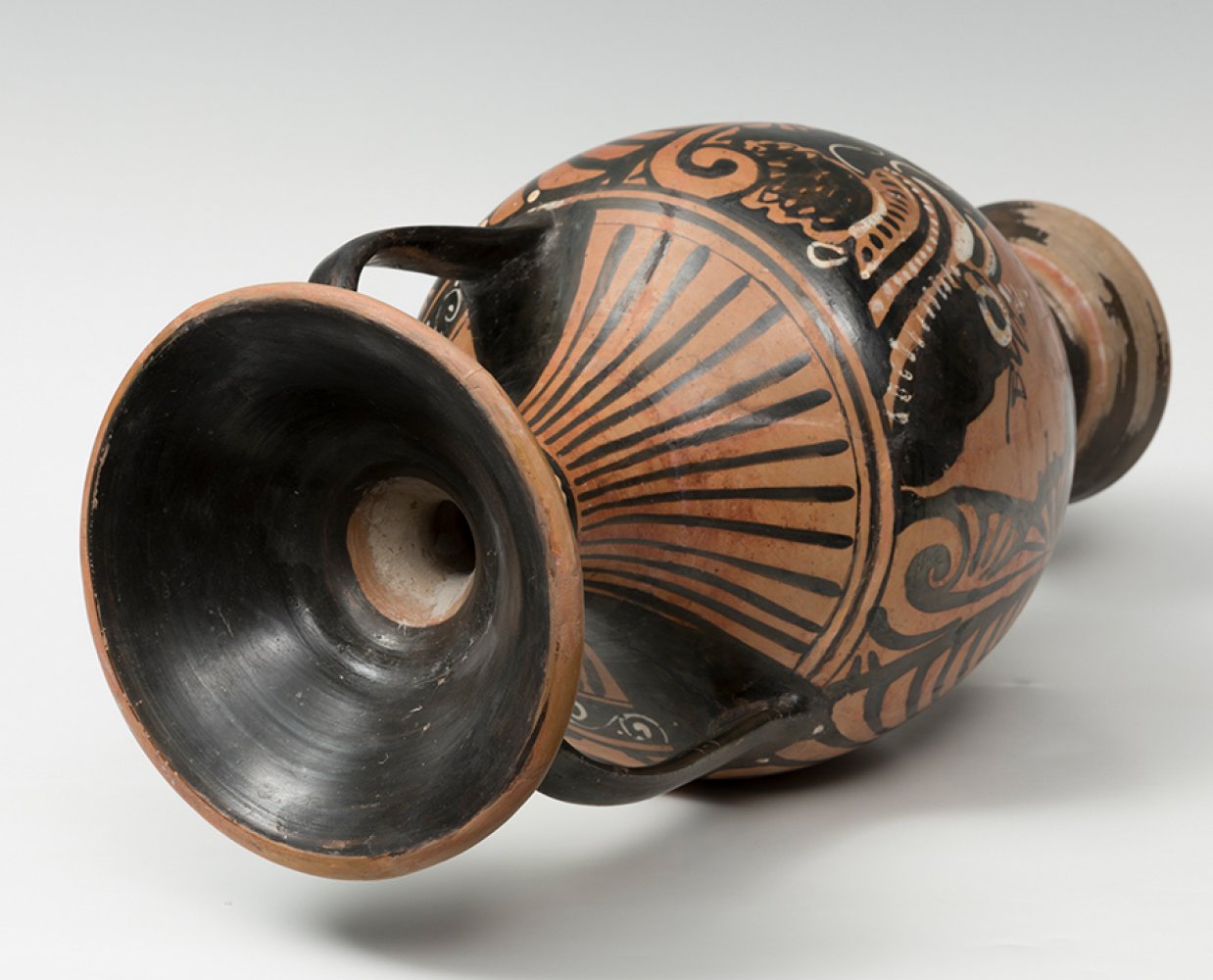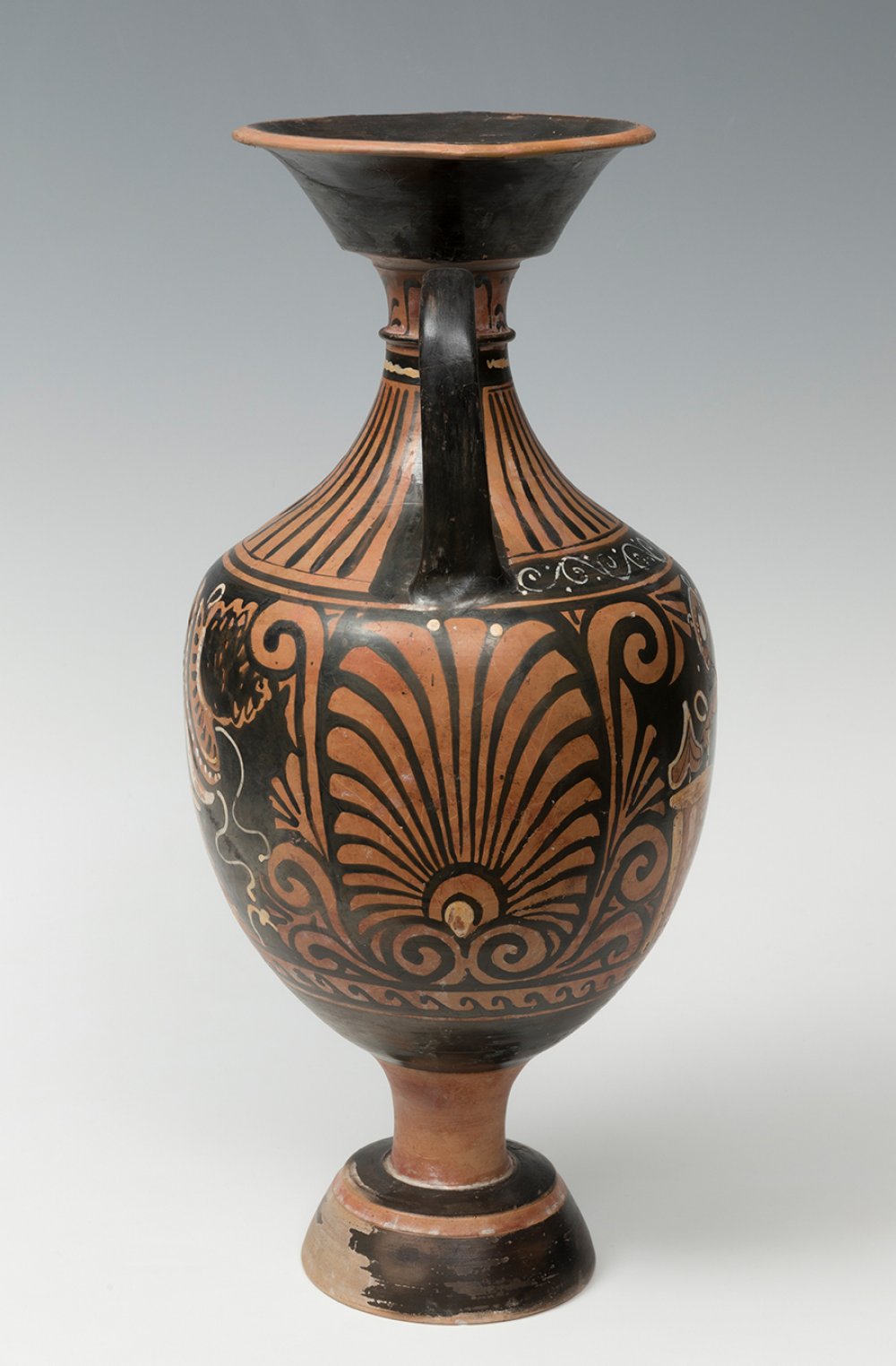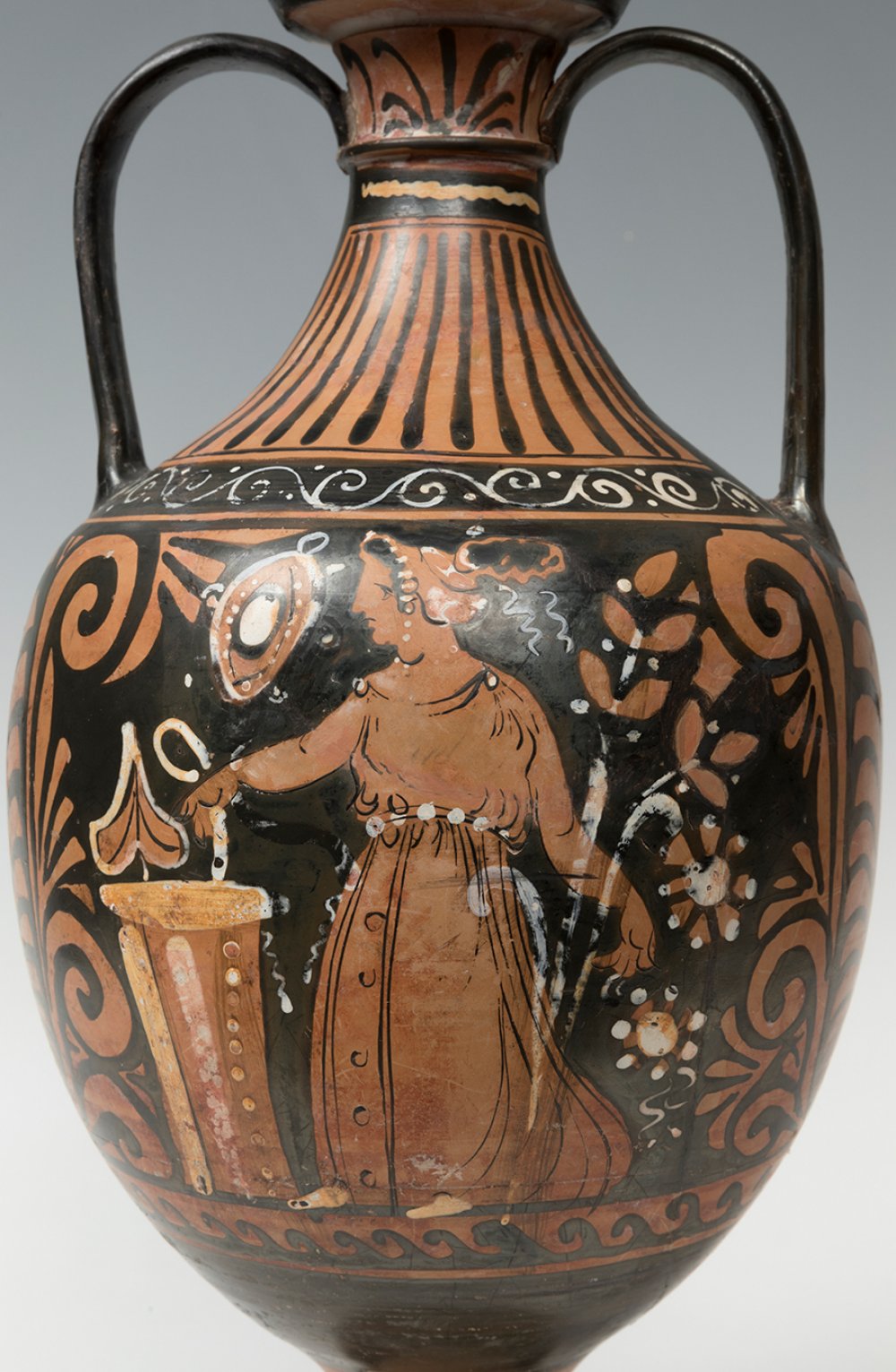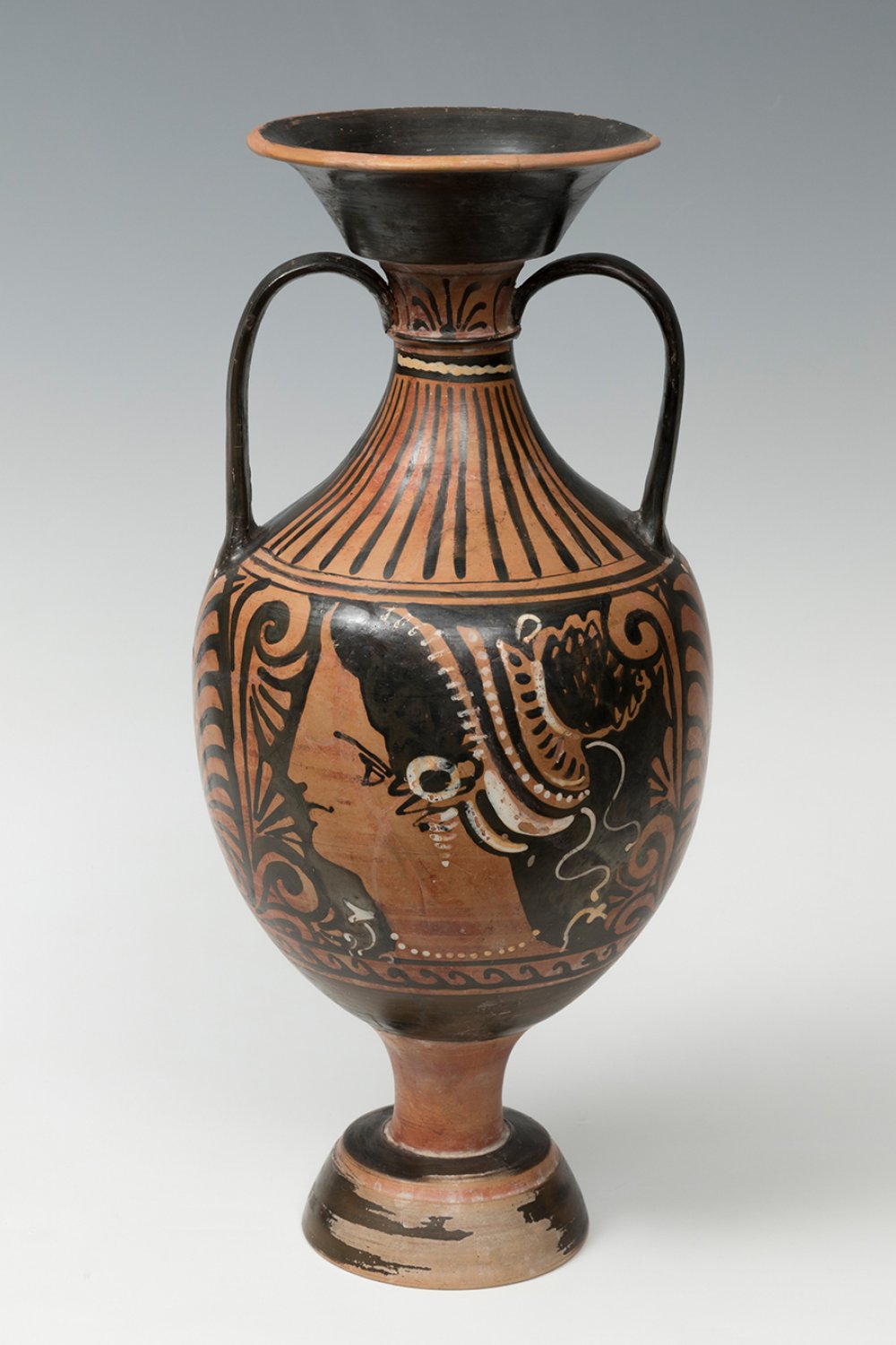3
Amphora; Magna Gratia, Apulia, 6th century BC.Ceramic with red figures.It has restorations on
Ceramic with red figures.
It has restorations on fracture lines and repainting.
Provenance: Belgian private collection.
Size: 42.5 x 20 x 17 cm.
Made using the red-figure technique, which stands out for its ornamental pattern, gathered in the body area. The foot is decorated with bands, combining black and red, giving way to the body where the figurative scene, conceived as a frieze, presents on one side the figure of a maenad holding a thyrsus and a leaf of ivy which she places on the altar, and on the other side the face of a lady fashion, both images separated by large palmettes arranged under the handles.
Amphorae are defined as a type with two vertical handles facing each other that go down from the mouth, which is narrow but with a very wide lip, to the beginning of the almost spherical body. It was intended for storing and transporting liquid or solid foodstuffs. The work comes from the region of Apulia in southern Italy, where Daunia, now the province of Foggia, and Messapia, in the southern part of the region, are located. From 320 BC onwards Athens no longer exported pottery, and only a few vessels were produced as prizes for athletes in the Panathenaeans. Pottery from the Italic Peninsula then took the place of Athenian pottery on the Mediterranean market.
Red-figure pottery was one of the most important figurative styles in Greek production. It developed in Athens around 530 BC, and was used until the 3rd century BC. It replaced the previous predominant style of black-figured pottery within a few decades. The technical basis was the same in both cases, but in the red figures the colouring is inverted, with the figures highlighted against a dark background, as if illuminated by a theatrical light, following a more natural pattern. Painters working with black figures were forced to keep the motifs well separated from each other and to limit the complexity of the illustration. The red-figure technique, on the other hand, allowed greater freedom. Each figure was silhouetted against a black background, allowing painters to portray anatomical details with greater accuracy and variety.
Ceramic with red figures.
It has restorations on fracture lines and repainting.
Provenance: Belgian private collection.
Size: 42.5 x 20 x 17 cm.
Made using the red-figure technique, which stands out for its ornamental pattern, gathered in the body area. The foot is decorated with bands, combining black and red, giving way to the body where the figurative scene, conceived as a frieze, presents on one side the figure of a maenad holding a thyrsus and a leaf of ivy which she places on the altar, and on the other side the face of a lady fashion, both images separated by large palmettes arranged under the handles.
Amphorae are defined as a type with two vertical handles facing each other that go down from the mouth, which is narrow but with a very wide lip, to the beginning of the almost spherical body. It was intended for storing and transporting liquid or solid foodstuffs. The work comes from the region of Apulia in southern Italy, where Daunia, now the province of Foggia, and Messapia, in the southern part of the region, are located. From 320 BC onwards Athens no longer exported pottery, and only a few vessels were produced as prizes for athletes in the Panathenaeans. Pottery from the Italic Peninsula then took the place of Athenian pottery on the Mediterranean market.
Red-figure pottery was one of the most important figurative styles in Greek production. It developed in Athens around 530 BC, and was used until the 3rd century BC. It replaced the previous predominant style of black-figured pottery within a few decades. The technical basis was the same in both cases, but in the red figures the colouring is inverted, with the figures highlighted against a dark background, as if illuminated by a theatrical light, following a more natural pattern. Painters working with black figures were forced to keep the motifs well separated from each other and to limit the complexity of the illustration. The red-figure technique, on the other hand, allowed greater freedom. Each figure was silhouetted against a black background, allowing painters to portray anatomical details with greater accuracy and variety.
29th September - Archaeology
Sale Date(s)
Venue Address
General delivery information available from the auctioneer
Setdart offers Worldwide shipping
PICK UP IN ROOM: You can come and pick up your lots in our offices (Barcelona, Madrid or Valencia). At the moment of the withdrawal, you will be able to accept the current conditions of the lot by means of a document that you will sign.
YOU CAN SEND ANOTHER PERSON TO PICK UP: This person must present a signed authorization that you can find in our web page by accessing from BUY AT SETDART- LOGISTICS-DOWNLOAD AUTHORIZATION DOCUMENT. You can also send an e-mail with the requested data in AUTHORIZATION DOCUMENT to admin@setdart.com
Important Information
25% buyer´s premium
21% buyer´s premium at www.setdart.com
Terms & Conditions
The maximum period to pay the lots is 7 working days. You can pay either via bank transfer or with credit card through our platform www.setdart.com (we only accept VISA or Mastercard).
BUYER´S PREMIUM: 22% Hammer price + 21% VAT from the buyer´s premium
If your piece has more than 100 years, our Ministry of Culture requires an export certificate in order for the piece to leave the country. Note that if the piece goes inside the EU, there is no cost for the export certificate. If the piece goes outside the EU, there is a cost for the export certificate. You can find more information in our Ministry of Culture website: https://www.culturaydeporte.gob.es/en/cultura/patrimonio/exportacionimportacion/exportacion/tasas.html
INQUIRIES: admin@setdart.com
Setdart guides you through the entire process, from the time of award to the day you receive your lot. Our logistics team will be happy to manage your transport, and will advise you on the best shipping method with professionals from the sector used to handling works of art and jewelry.
WE OFFER WORLDWIDE DOOR TO DOOR SHIPPING
PICK UP IN ROOM: You can come and pick up your lots in our offices. At the moment of the withdrawal, you will be able to accept the current conditions of the lot by means of a document that you will sign.
YOU CAN SEND ANOTHER PERSON TO PICK UP: This person must present a signed authorization that you can find in our web page by accessing from BUY AT SETDART-LOGISTICS-DOWNLOAD AUTHORIZATION DOCUMENT. You can also send an e-mail with the requested data in AUTHORIZATION DOCUMENT to admin@setdart.com
SETDART IS NOT RESPONSIBLE FOR THE STATE OF THE PARTS ONCE THEY LEAVE OUR FACILITIES. MRW SHIPMENTS: Once the payment is made, your lot will be packed for shipment, the logistics department will send you an e-mail notifying you of the day it leaves our warehouse, changes of address cannot be made after receiving this e-mail.
INSURANCE INCIDENTS: Coverage for the value of the auction up to 3000 ? per shipment, if the value of the auction is higher, Setdart will send you a quote including the additional insurance. The insurance company WILL NOT BE RESPONSIBLE FOR THE SHIPMENT THAT EXCEEDS THAT AMOUNT AND IS NOT FULLY INSURED. MRW INCIDENTS: Maximum notification 48 hours after receipt, after which the insurance company WILL NOT BE RESPONSIBLE AND NO CLAIMS WILL BE ACCEPTED.
E-MAIL LOGISTICS: logistica@setdart.com
PICK UP YOUR MESSAGES: You can send your own messaging, prior notice via e-mail that your shipment is ready, please note 3 or 4 days in advance. This type of shipment is packaged so Setdart will provide you with a quote.
EXPENSES FOR STORAGE: We inform you that if the purchased lot is not picked up within a month, you will be charged 30€ per week per lot. Setdart Online S.L., owner of the web site "setdart.com", "setdart.net" and "setdart.org", acts as a company of Spanish nationality inscribed in the Volume 36955, sheet 182, page B-293056 of the Mercantile Registry, with registered office at Calle Aragó















